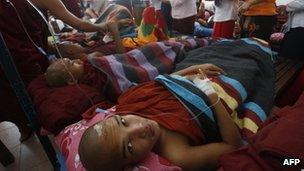Burma police 'used white phosphorous' on mine protesters
- Published

Many Buddhist monks were injured when the protests were broken up
Burmese police fired military-issue white phosphorus grenades to disperse protesters at a controversial copper mine, a new report says.
Scores of people, many of them monks, were injured and burned when authorities moved in to violently end months of demonstrations in November.
Burmese lawyers and the US-based Justice Trust compiled the report.
It was based on eyewitness testimony, photos and forensic analysis of a used grenade cartridge.
The mine at Monywa is jointly owned by a Chinese company and the Burmese military. Local villagers had embarked on months of sit-in protests, claiming they had been unfairly forced to give up their land.
No one from the Burmese government was available to comment immediately on the report.
An official commission established in the immediate aftermath of the violent conclusion of the protests has yet to deliver its findings.
'Military munitions'
The 41-page report says that in the early morning of 29 November, Burmese police repeatedly fired white phosphorus grenades, both into the air and along the ground into camps of protesters.
It quotes witnesses saying they saw bright flares in the sky, and that a sticky, flaming substance was released which set the camps on fire and burned through clothes, skin and flesh.
White phosphorus has often been used on the battlefield, such as in the Iraqi city of Fallujah. It is highly controversial.
"It's unheard of for police to use incendiary military munitions against peaceful protesters during a law enforcement operation," Roger Normand, director of the Justice Trust, said at the report's launch in Rangoon.
The authors of the report obtained one of the grenade cartridges used in the dispersal and tested it at an independent laboratory.
They say that the results showed levels of residue consistent with it being from white phosphorus.
The findings are supported by photos and witness accounts that were published at the time. Many of those injured were monks with horrific burns on their bodies.
The report also examined the villagers' grievances against the copper mine which led them to start the protest.
It alleges that local officials lied and intimidated them in order to make them sign contracts to hand over their land.
Many see the mine dispute as an important test case of how the now reform-minded Burmese authorities handle issues dating back to decades of military dictatorship.
In the immediate aftermath of the protests, Burmese President Thein Sein established an Investigation Commission led by opposition leader Aung San Suu Kyi.
Its initial brief was a far-reaching look at the copper mine, the protest and its violent dispersal.
Two days later, without explanation, the mandate was changed to exclude looking at the cause of the protests or why people had been injured. That report has yet to be made public.
- Published8 December 2012
- Published3 December 2012
- Published30 November 2012
- Published24 January 2013